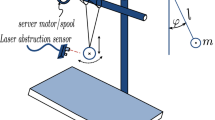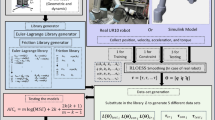Abstract
This paper affords dynamic modeling and control for a new 3D pantograph manipulator. The new manipulator possesses pure decoupled translational motions and it is characterized by large workspace to size ratio, high speed, rigidity, and accuracy. Euler-Lagrange first type method is used to get the dynamic model. However, the resulted dynamic model is too complex to be used in model-based control techniques. Therefore, a simplified nominal plant is proposed. It allows the inverse dynamic solution efficiently. However, an explicit form of the nominal Coriolis and centrifugal matrix cannot be obtained due to the complicated kinematic terms. Considering these dynamic characteristics as well as the required robust trajectory tracking performance of the manipulator, a new controller is proposed. The new controller is called inverse optimal PID with Feed-Forward Control which is designed in H∞ framework. The new controller has the following merits; robustness, optimality, simple implementation, and efficient execution without the need of explicit forms of dynamic matrices. The extended disturbance in the proposed controller is smaller than that in the inverse optimal PID control (IPID) and contains one type of error contrary to the nonlinear robust motion controller (NRIC). The performance of the proposed controller is compared with those of IPID and NRIC controllers for different trajectories and payloads. The dynamic simulation results via co-simulation of MSC-ADAMS® and MATLAB®/Simulink software prove the robustness of the proposed controller against speed/payload variations. The proposed controller is found to have higher performance compared with IPID and NRIC controllers. These results assure the feasibility of the 3D pantograph manipulator with the proposed controller for pure translational tracking applications.
Similar content being viewed by others
References
A. Noshadi, M. Mailah, and A. Zolfagharian, “Intelligent active force control of a 3-rrr parallel manipulator incorporating fuzzy resolved acceleration control,” Applied Mathematical Modelling, vol. 36, no. 6, pp. 2370–2383, 2012. [click]
L. Rey and R. Clavel, The delta parallel robot, In Parallel Kinematic Machines, Springer, pp. 401–417, 1999. [click]
S. Joshi and L.-W. Tsai, “A comparison study of two 3-dof parallel manipulators: One with three and the other with four supporting legs,” IEEE Transactions on Robotics and Automation, vol. 19, no. 2, pp. 200–209, 2003. [click]
D. Kanaan, P. Wenger, and D. Chablat, “Kinematic analysis of a serial-parallel machine tool: the verne machine,” Mechanism and Machine Theory, vol. 44, no. 2, pp. 487–498, 2009. [click]
C. Gosselin and X. Kong, Cartesian parallel manipulators, US Patent 6,729,202, May 4 2004.
M. Carricato and V. Parenti-Castelli, “Singularity-free fully-isotropic translational parallel manipulators,” ASME 2002 International Design Engineering Technical Conferences and Computers and Information in Engineering Conference, American Society of Mechanical Engineerspp. 1041–1050, 2002.
X. Kong and C. M. Gosselin, “Type synthesis of linear translational parallel manipulators,” Advances in robot kinematics, Springer, pp. 453–462, 2002.
X. Kong and C. M. Gosselin, “A class of 3-dof translational parallel manipulators with linear input-output equations,” Proceedings of the Workshop on Fundamental Issues and Future Research Directions for Parallel Mechanisms and Manipulators, pp. 25–32, 2002.
C.-C. Lee and J. M. Hervé, “Cartesian parallel manipulators with pseudoplanar limbs,” Journal of Mechanical Design, vol. 129, no. 12, pp. 1256–1264, 2007. [click]
H. S. Kim and L.-W. Tsai, “Evaluation of a cartesian parallel manipulator,” Advances in robot kinematics, Springer, pp. 21–28, 2002. [click]
M. Carricato and V. Parenti-Castelli, “A novel fully decoupled two-degrees-of-freedom parallel wrist,” The International Journal of Robotics Research, vol. 23, no. 6, pp. 661–667, 2004.
M. Ruggiu, “Kinematics analysis of the cur translational manipulator,” Mechanism and Machine Theory, vol. 43, no. 9, pp. 1087–1098, 2008.
W. Li, J. Zhang, and F. Gao, “P-cube, a decoupled parallel robot only with prismatic pairs,” Mechatronic and Embedded Systems and Applications, Proceedings of the 2nd IEEE/ASME International Conference on, IEEE, pp. 1–4, 2006.
S. Briot and I. Bonev, “Pantopteron: a new fully decoupled 3dof translational parallel robot for pick-and-place applications,” Journal of Mechanisms and Robotics, vol. 1, no. 2, p. 021001, 2009. [click]
M. Magdy, M. Fanni, A. M. Mohamed, and T. Miyashita, “Kinematic design and novel mobility analysis of a new 3d pantograph decoupled manipulator,” Mechanism and Machine Theory, vol. 117, pp. 253–275, 2017. [click]
M. Lashin, M. Fanni, M. Magdy, and A. M. Mohamed, “Pd type of fuzzy controller for a new 3dof fully decoupled translational manipulator,” 2016 2nd International Conference on Control, Automation and Robotics (ICCAR), IEEE, pp. 263–267, 2016.
J. Park, W. Chung, and Y. Youm, “Analytic nonlinear h infinity optimal control for robotic manipulators,” Robotics and Automation, 1998. Proceedings. 1998 IEEE International Conference on, vol. 3, IEEE, pp. 2709–2715, 1998.
Y. Choi, W. K. Chung, and I. H. Suh, “Performance and h infinity optimality of pid trajectory tracking controller for lagrangian systems,” IEEE Transactions on Robotics and Automation, vol. 17, no. 6, pp. 857–869, 2001. [click]
M. J. Kim, S. Park, and W. K. Chung, “Nonlinear robust internal loop compensator for robust control of robotic manipulators,” International Conference on Intelligent Robots and Systems (IROS), 2012 IEEE/RSJ, IEEE, pp. 2742–2748, 2012. [click]
Y. Choi and W. K. Chung, PID trajectory tracking control for mechanical systems, vol. 298, Springer, 2004.
D. G. Chetwynd and C. M. Gosselin, Conceptual design and dimensional synthesis of a novel 2-dof translational parallel robot for pick-and-place operations, 2004.
S. Macfarlane, E. Croft, et al. “Jerk-bounded manipulator trajectory planning: design for real-time applications,” IEEE Transactions on Robotics and Automation, vol. 19, no. 1, pp. 42–52, 2003. [click]
Y. Wei, J. Qiu, and H. R. Karimi, “Reliable output feedback control of discrete-time fuzzy affine systems with actuator faults,” IEEE Transactions on Circuits and Systems I: Regular Papers, 2016.
Y. Wei, J. Qiu, H. R. Karimi, and M. Wang, “Model reduction for continuous-time markovian jump systems with incomplete statistics of mode information,” International Journal of Systems Science, vol. 45, no. 7, pp. 1496–1507, 2014. [click]
Y. Wei, J. Qiu, H. R. Karimi, and M. Wang, “Model approximation for two-dimensional markovian jump systems with state-delays and imperfect mode information,” Multidimensional Systems and Signal Processing, vol. 26, no. 3, pp. 575–597, 2015. [click]
Y. Wei, J. Qiu, and H. R. Karimi, “Quantized H ∞ filtering for continuous-time markovian jump systems with deficient mode information,” Asian Journal of Control, vol. 17, no. 5, pp. 1914–1923, 2015. [click]
Y. Wei, J. Qiu, H. R. Karimi, and M. Wang, “Filtering design for two-dimensional markovian jump systems with state-delays and deficient mode information,” Information Sciences, vol. 269, pp. 316–331, 2014. [click]
Author information
Authors and Affiliations
Corresponding author
Additional information
Recommended by Associate Editor Yingmin Jia under the direction of Editor Yingmin Jia. The first author is supported by a scholarship from the Mission Department, Ministry of Higher Education of the Government of Egypt which is gratefully acknowledged.
Manar Lashin was born in Kalyobiya, Egypt, in 1987. She has received the B.Sc. in control and measurements from Benha University, Kalyobiya, Egypt and received the M.Sc. degree in mechatronics and robotics from Egypt-Japan University of Science and Technology (EJUST), Alexandria, Egypt. She is currently working toward a Ph.D. degree in mechatronics and robotics at EJUST. Her research interests include nonlinear control, robust control, robot kinematics, dynamic and modeling.
Mohamed Fanni received the B.E. and M.Sc. degrees in mechanical engineering from Faculty of Engineering of both Cairo University and Mansoura University, Egypt, in 1981 and 1986, respectively and the Ph.D. degree in engineering from Karlsruhe University, Germany, 1993. He is a Professor with the Dept. of Mechatronics and Robotics Engineering Egypt-Japan University of Science and Technology E-JUST, Alexandria, on leave from Production Engineering and Mechanical Design Department, Faculty of Engineering, Mansoura University, Egypt. His major research interests include robotics engineering, automatic control, and Mechanical Design. His current research focuses on Design and Control of Mechatronic Systems, Surgical Manipulators, Teleoperation systems and Flying/Walking Robots.
Abdelfatah Mohamed received the Ph.D. degree from University of Maryland, College Park, USA in 1990. Since 1990 he has been an Assistant Professor with the Dept. of Electrical Engineering, Assiut University, Egypt. He became an Associate Professor in 1995, and Professor in 2000. From September 1990 to August 1993, He has been a Postdoctoral Fellow at the Dept. of Mechanical Engineering, University of Texas, Austin USA. From April 1996 to April 1997, He has been a visiting Professor at the Dept. of Electrical Engineering, Kanazawa University, Japan. From September 2010 to March 2012 He has been the Head, Dept. of Electrical Engineering, Assiut University, and became the Dean of Faculty of Engineering, Assiut University on March 2012. Currently, he is the Head of the Dept. of Mechatronics and Robotics Engineering, Egypt-Japan University of Science and Technology. His research interest lies in Robust and Intelligent control, Magnetic Bearing systems, Robotics, Industrial drives. Dr. Mohamed is a senior IEEE member.
Tomoyuki Miyashita was born in Japan in 1968. He received the B.E., M.E., and Ph.D. degrees from Waseda University, Tokyo, Japan, in 1990, 1992, and 2001, respectively. He joined Nippon Steel Corporation, Tokyo, Japan, in 1992. Since 1998, he has been with the Graduate School of Engineering, Waseda University, where he is currently a Professor. His main areas of research interest are mechanical design considering dynamical properties, flexible space structures, and their control systems. Dr. Miyashita is a member of The Japan Society of Computer Aided Surgery, The Japan Society of Mechanical Engineers, Japan Society for Design Engineering, The American Institute of Aeronautics and Astronautics, The Institute of Electrical and Electronics Engineers.
Rights and permissions
About this article
Cite this article
Lashin, M., Fanni, M., Mohamed, A.M. et al. Dynamic Modeling and Inverse Optimal PID with Feed-forward Control in H∞ Framework for a Novel 3D Pantograph Manipulator. Int. J. Control Autom. Syst. 16, 39–54 (2018). https://doi.org/10.1007/s12555-016-0740-0
Received:
Revised:
Accepted:
Published:
Issue Date:
DOI: https://doi.org/10.1007/s12555-016-0740-0




